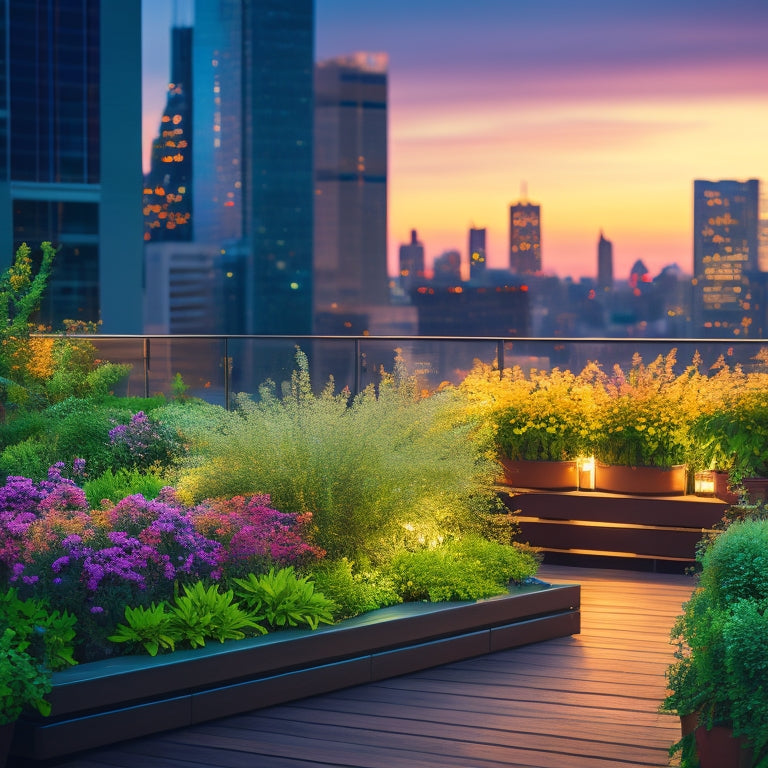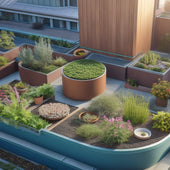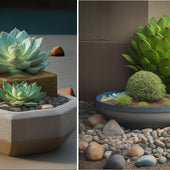
Why Rooftop Gardens Are a Must for Modern Homes
Share
As you design your modern home, don't overlook the rooftop's potential. By optimizing space with symmetrical layouts, multi-functional elements, and vertical gardening, you can create a tranquil retreat that feels expansive even in compact spaces. Incorporate ambient lighting, task lighting, and solar lights to set the tone and highlight features. Select plants that thrive in containers and tolerate harsh conditions, and group them by water requirements. With sustainable practices, creative upcycling, and cozy ambiance, your rooftop garden will be a must-have feature. As you explore these strategies, you'll uncover even more innovative ways to transform your rooftop into a stunning oasis.
Key Takeaways
• Rooftop gardens optimize space in small areas, providing a tranquil retreat that feels expansive and increases property value.
• Incorporating vertical gardening elements like green walls and wall-mounted planters maximizes space utilization and efficiency.
• Aesthetic and functional lighting solutions, such as solar and ambient lighting, enhance the ambiance and relaxation of rooftop gardens.
• Sustainable practices, including recycled materials and upcycling, promote eco-friendliness and reduce waste in rooftop garden design.
• Rooftop gardens provide a unique opportunity for outdoor living, entertainment, and relaxation, making them a must-have for modern homes.
Maximizing Space in Small Areas
How do you optimize your rooftop garden's layout to accommodate a lush oasis in a compact space, where every square foot counts?
To maximize space in small areas, you'll need to employ space-saving solutions that don't compromise on aesthetics or functionality. Start by evaluating your rooftop's dimensions and identifying areas that can be utilized efficiently.
Consider a symmetrical garden layout to create a sense of balance and harmony. Use rectangular planters or beds with clean lines to define different zones within the garden, making the most of every inch.
Incorporate multi-functional elements, such as built-in seating or storage, to reduce clutter and increase usability. Make the most of corners by using triangular planters or curved benches that fit snugly into these often-wasted spaces.
By carefully planning your garden layout, you can create a tranquil retreat that feels expansive, even in the smallest of rooftop spaces.
With a little creativity and strategic planning, you can turn your compact rooftop into a lush oasis that's perfect for relaxation and entertainment.
Incorporating Vertical Gardening Elements
As you design your rooftop garden, you'll want to contemplate incorporating green walls that rise vertically, making the most of your available space.
By doing so, you'll not only maximize your garden's efficiency but also create a stunning visual display.
With a well-planned vertical garden, you can turn even the smallest rooftop area into a lush oasis.
Green Walls Rise
By incorporating green walls into your rooftop garden design, you can maximize space while creating a visually stunning display of lush foliage that also provides insulation and improves air quality. This innovative approach to vertical gardening not only enhances the aesthetic appeal of your rooftop oasis but also offers several practical benefits.
Here are just a few advantages of incorporating green walls into your design:
-
Improved air quality: Green walls help purify the air by absorbing pollutants and releasing oxygen, creating a healthier environment for you and your family.
-
Enhanced insulation: The dense foliage of green walls acts as a natural insulator, reducing heat loss in the winter and heat gain in the summer, resulting in lower energy bills.
-
Increased biodiversity: By providing a habitat for local wildlife, green walls support sustainable gardening practices and promote ecological balance.
Maximizing Space Efficiently
Incorporating vertical gardening elements into your rooftop garden design enables you to make the most of available space, creating a thriving oasis that bursts with foliage and color.
By using wall-mounted planters, trellises, and living walls, you can increase your garden's capacity without sacrificing precious floor space. This compact gardening approach allows you to grow a diverse range of plants, from herbs and vegetables to flowers and shrubs, in a small footprint.
To further optimize your rooftop garden's layout, consider incorporating multi-functional furniture pieces that serve more than one purpose.
For example, a planter bench can provide seating while also housing plants, while a storage ottoman can stash gardening tools and supplies.
By choosing furniture that doubles as planters or storage, you can create a seamless and efficient space that's both functional and visually appealing.
With careful planning and clever design, you can create a rooftop garden that's both beautiful and productive, even in the most compact of spaces.
Rooftop Garden Lighting Essentials
Designing a rooftop garden's lighting scheme involves selecting fixtures that not only provide adequate illumination but also withstand harsh outdoor conditions and complement the overall aesthetic of your modern home. As you plan your rooftop oasis, consider the type of lighting you need to create the perfect ambiance.
You'll want to incorporate a mix of lighting types to achieve the desired effect. Here are some essentials to keep in mind:
-
Solar lighting: harness the power of the sun to illuminate your rooftop garden, reducing your carbon footprint and energy bills.
-
Ambient glow: use string lights or fairy lights to create a soft, warm ambiance that invites relaxation and socializing.
-
Task lighting: install spotlights or pathway lights to highlight specific features or guide visitors through your rooftop garden.
Choosing the Right Plant Species
When selecting plant species for your rooftop garden, you'll want to opt for varieties that not only thrive in containers but also tolerate exposure to harsh weather conditions, intense sunlight, and strong winds.
Consider plants with deep roots, like succulents, that can anchor themselves against gusty winds. For seasonal selection, choose plants that complement the climate and time of year. In temperate regions, opt for plants like petunias, marigolds, or zinnias that bloom in the spring and summer. In regions with mild winters, select plants like kale, spinach, or pansies that thrive in the cooler months.
Ensure plant compatibility by grouping plants with similar growing conditions together. Place plants with high water requirements, like ferns or peace lilies, in areas with adequate irrigation. Conversely, plants like sedums or cacti that require minimal watering should be placed in areas with limited water supply.
Utilizing Recycled Materials Creatively
As you design your rooftop garden, you'll want to think creatively about how to repurpose urban debris and old materials, giving them new life in your outdoor space.
You can transform discarded items into functional features, such as turning an old pallet into a planter or using broken tiles to create a mosaic pathway.
Repurposed Urban Debris
Transforming discarded urban materials into functional components, you can craft unique rooftop garden features that not only reduce waste but also inject personality into your outdoor space. This creative approach to urban sustainability not only benefits the environment but also allows you to express your individuality through design.
By repurposing urban debris, you can:
-
Create planters from old shipping pallets or wooden crates, adding a touch of industrial chic to your garden.
-
Use broken tiles or glass to craft a mosaic pathway, adding color and texture to your rooftop oasis.
-
Transform an old bicycle or car tire into a quirky planter or trellis, adding a touch of whimsy to your garden.
Through creative design and resourcefulness, you can turn would-be waste into functional and visually appealing elements that reflect your personal style.
Old Materials, New Life
By salvaging and reimagining discarded materials, you can breathe new life into old objects, turning them into functional and visually striking elements that define your rooftop garden's unique character.
For instance, you can repurpose old wooden pallets as planters or trellises, adding a touch of rustic charm to your outdoor space.
Similarly, vintage metal drums can be transformed into self-watering planters, reducing waste and conserving resources.
Trash to Treasure
You can release the hidden potential of discarded materials by creatively repurposing them into functional and aesthetically pleasing components for your rooftop garden. By thinking outside the box, you can transform trash into treasure, reducing waste and adding a touch of uniqueness to your outdoor space.
Here are some inspiring ideas to get you started:
-
Old pallets become planters: Upcycle wooden pallets into planters for herbs, succulents, or flowers, adding a rustic touch to your rooftop garden.
-
Glass bottles turn into wind chimes: Use recycled glass bottles to create a melodious wind chime, adding a soothing soundtrack to your outdoor oasis.
-
Repurposed metal drums become seating: Transform metal drums into quirky, eco-friendly seating options, perfect for lounging amidst your lush rooftop garden.
Creating a Cozy Outdoor Ambiance
Set the tone for a cozy outdoor ambiance by incorporating warm, inviting elements, such as string lights, lanterns, or a fire pit, to create a sense of comfort and relaxation in your rooftop garden. These elements won't only illuminate your space but also add a touch of warmth and personality to your outdoor decor.
To take it a step further, consider incorporating cozy seating options, such as plush outdoor sofas, hammocks, or sectionals, that will invite you to linger and unwind.
When selecting your outdoor furniture, opt for weather-resistant materials and durable fabrics that can withstand the elements. You can also add throws, pillows, and blankets in warm, rich colors to create a cozy atmosphere.
Consider the layout of your rooftop garden and create conversational areas that encourage socializing and relaxation. By incorporating these elements, you'll be able to create a cozy outdoor ambiance that's perfect for unwinding after a long day or entertaining friends and family.
Incorporating Water Features Wisely
As you've crafted a cozy outdoor ambiance, now it's time to bring in the soothing sounds and visual appeal of water features, which can elevate your rooftop garden's sense of serenity and relaxation. Water features can be a game-changer in creating a tranquil atmosphere, but it's crucial to incorporate them wisely.
Here are some key considerations to keep in mind:
-
Optimize water circulation: Verify that your water feature has a proper circulation system to prevent stagnation and maintain water quality. This will also help reduce maintenance and prevent mosquito breeding.
-
Choose the right sound: Select a water feature that produces a calming sound, such as a gentle trickle or soft gurgle. This will enhance the sound therapy benefits and create a more peaceful environment.
-
Consider visibility: Strategically place your water feature to maximize visual appeal. A well-placed fountain or pond can create a stunning visual focal point, drawing the eye and inviting relaxation.
Ensuring Structural Integrity Matters
One vital aspect of rooftop garden design that's often overlooked is the structural integrity of the roof itself, which must be able to support the weight of the garden, including soil, plants, and water features.
You can't just assume your roof can handle the added load; you need to verify it's capable of withstanding the extra weight. A structural assessment is essential to determine the roof's load-bearing capacity. This involves evaluating the roof's material, age, and condition to calculate its maximum weight limit.
You'll need to take into account factors like the weight of the soil, plants, and water features, as well as any additional elements like walkways, seating, or pergolas. By conducting a thorough structural assessment, you can determine the maximum roof load your rooftop garden can safely support.
This will give you the confidence to design and build a stunning rooftop oasis that's both beautiful and safe. Don't risk compromising your roof's integrity – prioritize a structural assessment to guarantee your dream rooftop garden becomes a reality.
Maintaining a Lush Rooftop Oasis
To keep your rooftop garden thriving, you'll need to establish a regular maintenance routine that includes tasks like pruning, fertilizing, and monitoring soil moisture levels. This will guarantee your plants receive the necessary care to flourish in their unique environment.
As you tend to your rooftop oasis, keep the following seasonal maintenance tasks in mind:
-
Spring: Inspect your garden's soil health by checking for signs of erosion, nutrient depletion, or pest infestations. Apply organic fertilizers and pest control methods as needed.
-
Summer: Monitor soil moisture levels closely, as rooftop gardens can dry out quickly. Water plants deeply but infrequently to encourage deep root growth.
-
Fall: Prune plants to maintain their shape and promote healthy growth. Remove any dead or dying plant material to prevent the spread of disease.
Frequently Asked Questions
Can Rooftop Gardens Increase a Property's Resale Value?
As you weigh the costs, consider this gem: a rooftop garden can be the crown jewel that boosts your property's resale value, with a property appraisal likely to reflect the landscaping benefits, adding up to a 10-15% increase, a savvy investment in your future.
Do Rooftop Gardens Require Special Permits or Licenses?
You'll need to navigate local building regulations and zoning laws to determine if special permits or licenses are required for your rooftop garden, as these vary by jurisdiction and can be quite specific.
How Do I Handle Rooftop Garden Pests and Rodents?
As you tend to your rooftop oasis, pesky pests and sneaky rodents lurk in the shadows, threatening to destroy your serene escape. You'll need to deploy a multi-pronged attack, combining natural pest control methods with rodent prevention strategies to safeguard your garden haven.
Are Rooftop Gardens Suitable for High-Rise Buildings?
When you're planning a rooftop garden on a high-rise building, you'll need to take into account design elements that guarantee structural integrity, such as load-bearing capacity and wind resistance, to create a safe and thriving oasis.
Can I Install a Rooftop Garden Over an Existing Roof?
You'll need to assess your existing roof's structural integrity and suitability of roofing materials before installing a rooftop garden, conducting thorough structural assessments to guarantee a safe and durable green space that meets your needs.
Related Posts
-

How Much Do Concrete Planters Weigh
When creating a concrete planter, you'll need to take into account the weight implications of your design. The type a...
-

How Much Do Concrete Planters Weigh
When creating a concrete planter, you'll need to take into account the weight implications of your design. The type a...
-

How Much Do Concrete Planters Weigh
When creating a concrete planter, you'll need to take into account the weight implications of your design. The type a...
-

How Much Do Concrete Planters Weigh
When creating a concrete planter, you'll need to take into account the weight implications of your design. The type a...
-

How Much Do Concrete Planters Weigh
When creating a concrete planter, you'll need to take into account the weight implications of your design. The type a...
-

How Much Do Concrete Planters Weigh
When creating a concrete planter, you'll need to take into account the weight implications of your design. The type a...
-

How Much Do Concrete Planters Weigh
When creating a concrete planter, you'll need to take into account the weight implications of your design. The type a...
-

How Much Do Concrete Planters Weigh
When creating a concrete planter, you'll need to take into account the weight implications of your design. The type a...
-

How Much Do Concrete Planters Weigh
When creating a concrete planter, you'll need to take into account the weight implications of your design. The type a...
-

How Much Do Concrete Planters Weigh
When creating a concrete planter, you'll need to take into account the weight implications of your design. The type a...
-

How Much Do Concrete Planters Weigh
When creating a concrete planter, you'll need to take into account the weight implications of your design. The type a...
-

How Much Do Concrete Planters Weigh
When creating a concrete planter, you'll need to take into account the weight implications of your design. The type a...
-

How Much Do Concrete Planters Weigh
When creating a concrete planter, you'll need to take into account the weight implications of your design. The type a...
-

How Much Do Concrete Planters Weigh
When creating a concrete planter, you'll need to take into account the weight implications of your design. The type a...
-

How Much Do Concrete Planters Weigh
When creating a concrete planter, you'll need to take into account the weight implications of your design. The type a...
-

How Much Do Concrete Planters Weigh
When creating a concrete planter, you'll need to take into account the weight implications of your design. The type a...
-

How Much Do Concrete Planters Weigh
When creating a concrete planter, you'll need to take into account the weight implications of your design. The type a...
-

How Much Do Concrete Planters Weigh
When creating a concrete planter, you'll need to take into account the weight implications of your design. The type a...
-

How Much Do Concrete Planters Weigh
When creating a concrete planter, you'll need to take into account the weight implications of your design. The type a...
-

How Much Do Concrete Planters Weigh
When creating a concrete planter, you'll need to take into account the weight implications of your design. The type a...
-

How Much Do Concrete Planters Weigh
When creating a concrete planter, you'll need to take into account the weight implications of your design. The type a...
-

How Much Do Concrete Planters Weigh
When creating a concrete planter, you'll need to take into account the weight implications of your design. The type a...
-

How Much Do Concrete Planters Weigh
When creating a concrete planter, you'll need to take into account the weight implications of your design. The type a...
-

How Much Do Concrete Planters Weigh
When creating a concrete planter, you'll need to take into account the weight implications of your design. The type a...
-

How Much Do Concrete Planters Weigh
When creating a concrete planter, you'll need to take into account the weight implications of your design. The type a...
-

How Much Do Concrete Planters Weigh
When creating a concrete planter, you'll need to take into account the weight implications of your design. The type a...
-

How Much Do Concrete Planters Weigh
When creating a concrete planter, you'll need to take into account the weight implications of your design. The type a...
-

How Much Do Concrete Planters Weigh
When creating a concrete planter, you'll need to take into account the weight implications of your design. The type a...
-

How Much Do Concrete Planters Weigh
When creating a concrete planter, you'll need to take into account the weight implications of your design. The type a...
-

3 Best Roof Garden Drainage Solutions for Planters
When designing your roof garden, you'll want to implement a planter drainage system that guarantees water flows freel...
-

3 Best Roof Garden Drainage Solutions for Planters
When designing your roof garden, you'll want to implement a planter drainage system that guarantees water flows freel...
-

3 Best Roof Garden Drainage Solutions for Planters
When designing your roof garden, you'll want to implement a planter drainage system that guarantees water flows freel...
-

3 Best Roof Garden Drainage Solutions for Planters
When designing your roof garden, you'll want to implement a planter drainage system that guarantees water flows freel...
-

3 Best Roof Garden Drainage Solutions for Planters
When designing your roof garden, you'll want to implement a planter drainage system that guarantees water flows freel...
-

3 Best Roof Garden Drainage Solutions for Planters
When designing your roof garden, you'll want to implement a planter drainage system that guarantees water flows freel...
-

3 Best Roof Garden Drainage Solutions for Planters
When designing your roof garden, you'll want to implement a planter drainage system that guarantees water flows freel...
-

3 Best Roof Garden Drainage Solutions for Planters
When designing your roof garden, you'll want to implement a planter drainage system that guarantees water flows freel...
-

3 Best Roof Garden Drainage Solutions for Planters
When designing your roof garden, you'll want to implement a planter drainage system that guarantees water flows freel...
-

3 Best Roof Garden Drainage Solutions for Planters
When designing your roof garden, you'll want to implement a planter drainage system that guarantees water flows freel...
-

3 Best Roof Garden Drainage Solutions for Planters
When designing your roof garden, you'll want to implement a planter drainage system that guarantees water flows freel...
-

3 Best Roof Garden Drainage Solutions for Planters
When designing your roof garden, you'll want to implement a planter drainage system that guarantees water flows freel...
-

3 Best Roof Garden Drainage Solutions for Planters
When designing your roof garden, you'll want to implement a planter drainage system that guarantees water flows freel...
-

Succulent-Friendly Drainage Solutions for Block Planters
You can create a succulent-friendly drainage system in your cinder block planters by drilling holes in the bottom of ...
-

Succulent-Friendly Drainage Solutions for Block Planters
You can create a succulent-friendly drainage system in your cinder block planters by drilling holes in the bottom of ...
-

Succulent-Friendly Drainage Solutions for Block Planters
You can create a succulent-friendly drainage system in your cinder block planters by drilling holes in the bottom of ...
-

Succulent-Friendly Drainage Solutions for Block Planters
You can create a succulent-friendly drainage system in your cinder block planters by drilling holes in the bottom of ...
-

Succulent-Friendly Drainage Solutions for Block Planters
You can create a succulent-friendly drainage system in your cinder block planters by drilling holes in the bottom of ...
-

Succulent-Friendly Drainage Solutions for Block Planters
You can create a succulent-friendly drainage system in your cinder block planters by drilling holes in the bottom of ...
-

Succulent-Friendly Drainage Solutions for Block Planters
You can create a succulent-friendly drainage system in your cinder block planters by drilling holes in the bottom of ...
-

Succulent-Friendly Drainage Solutions for Block Planters
You can create a succulent-friendly drainage system in your cinder block planters by drilling holes in the bottom of ...
-

Succulent-Friendly Drainage Solutions for Block Planters
You can create a succulent-friendly drainage system in your cinder block planters by drilling holes in the bottom of ...
-

Succulent-Friendly Drainage Solutions for Block Planters
You can create a succulent-friendly drainage system in your cinder block planters by drilling holes in the bottom of ...
-

Succulent-Friendly Drainage Solutions for Block Planters
You can create a succulent-friendly drainage system in your cinder block planters by drilling holes in the bottom of ...
-

Succulent-Friendly Drainage Solutions for Block Planters
You can create a succulent-friendly drainage system in your cinder block planters by drilling holes in the bottom of ...
-

Succulent-Friendly Drainage Solutions for Block Planters
You can create a succulent-friendly drainage system in your cinder block planters by drilling holes in the bottom of ...
-

Succulent-Friendly Drainage Solutions for Block Planters
You can create a succulent-friendly drainage system in your cinder block planters by drilling holes in the bottom of ...
-

Succulent-Friendly Drainage Solutions for Block Planters
You can create a succulent-friendly drainage system in your cinder block planters by drilling holes in the bottom of ...


